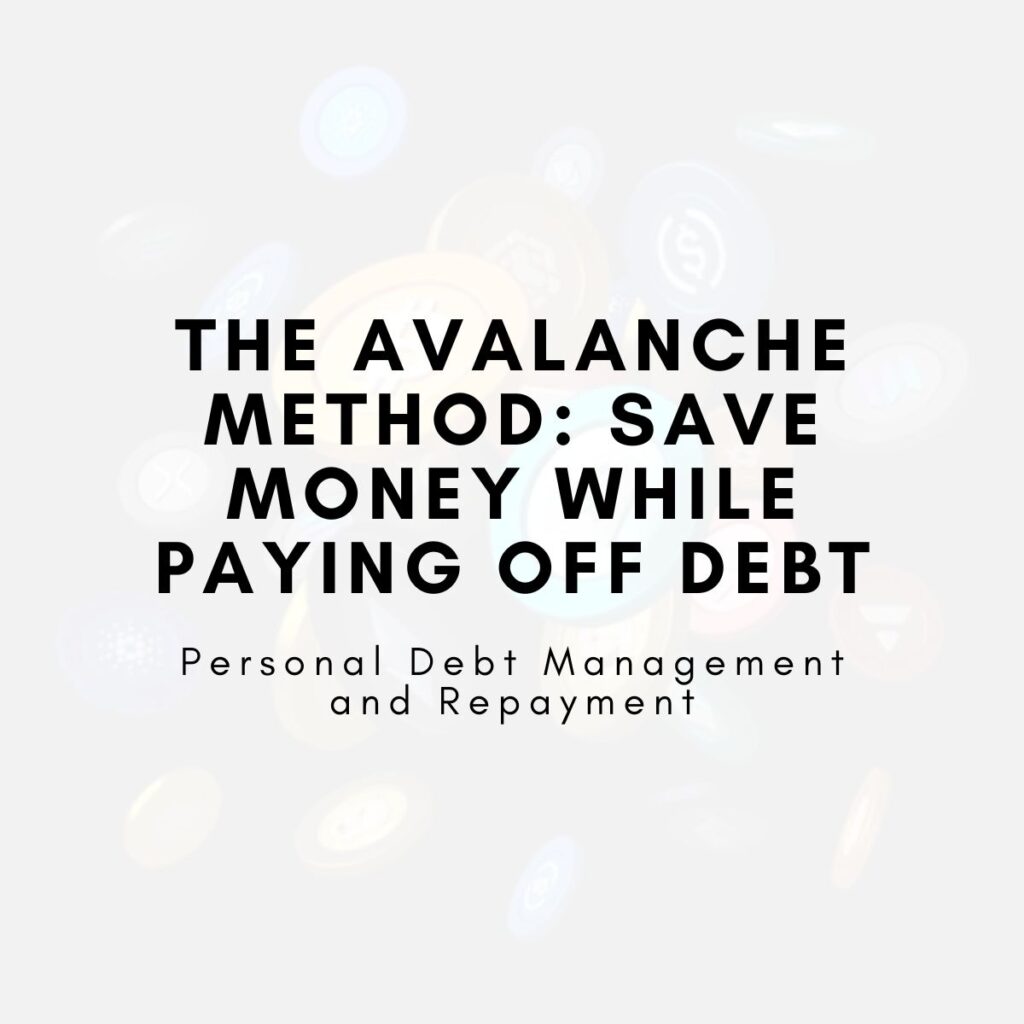
How can the Avalanche Method help you save money while paying off debt?
The Avalanche Method is a strategy for paying off debt that focuses on prioritizing high-interest debts. By tackling the highest-interest debt first, you minimize the amount of interest you pay over time, helping you save money while working toward becoming debt-free. In this guide, we will explore how the Avalanche Method works, its benefits, and how you can implement it to save money while reducing your debt.
Summary Table: The Avalanche Method: Save Money While Paying Off Debt
| Step | Action | Example |
|---|---|---|
| 1. Understand the Avalanche Method | Focus on paying off the highest-interest debt first while making minimum payments on others. | Start by paying off a $5,000 credit card debt at 20% interest before moving to a $10,000 personal loan at 8%. |
| 2. List All Debts | List all your debts, including the balance, interest rate, and minimum payment for each. | Example: Credit Card ($5,000, 20%), Personal Loan ($10,000, 8%), Student Loan ($25,000, 4%). |
| 3. Prioritize by Interest Rate | Arrange debts in order of interest rate, from highest to lowest. | Focus on the credit card debt first, followed by the personal loan and student loan. |
| 4. Make Minimum Payments | Continue making minimum payments on all other debts while prioritizing the highest-interest debt. | Pay the minimum for the student loan and personal loan while focusing on the credit card debt. |
| 5. Allocate Extra Funds to the Highest-Interest Debt | Apply any extra funds you can to the highest-interest debt to pay it off faster. | Apply an extra $200 per month toward the $5,000 credit card balance. |
| 6. Move to the Next Debt | Once the highest-interest debt is paid off, apply its payment amount to the next highest-interest debt. | Once the credit card debt is cleared, use the extra $300 to pay off the personal loan. |
| 7. Track Your Progress | Use debt trackers or budgeting apps to monitor your repayment journey. | Use an app like Mint to track your progress and adjust your budget accordingly. |
| 8. Celebrate Milestones | Celebrate each debt you pay off to maintain motivation. | Reward yourself with a small treat or activity after paying off each debt. |
| 9. Challenges of the Avalanche Method | Acknowledge that large debts may take time to pay off, and the progress can feel slow. | The $25,000 student loan at 4% interest might take longer to pay off compared to smaller, high-interest debts. |
| 10. Staying Motivated | Stay focused, maintain discipline, and celebrate your victories along the way. | Track progress visually, such as with a debt repayment chart or calendar, and celebrate when reaching milestones. |
This table summarizes the key actions involved in using the Avalanche Method to save money while paying off debt, along with examples to guide you through the process.
Introduction
When it comes to paying off debt, there are many strategies to choose from, each with its own set of advantages. One of the most effective methods for saving money while paying off debt is the Avalanche Method. This approach focuses on tackling high-interest debts first, which helps you reduce the overall amount of interest you pay over time.
In this post, we’ll explore how the Avalanche Method works, its benefits and challenges, and provide step-by-step instructions on how you can implement it to save money while clearing your debts. Whether you’re dealing with credit card debt, student loans, or personal loans, this method can help you pay off your debts in the most cost-effective manner.
1. Understanding the Avalanche Method
The Avalanche Method is a debt repayment strategy that prioritizes paying off high-interest debts first, while making minimum payments on all other debts. Once the highest-interest debt is paid off, you move on to the next highest-interest debt. This method reduces the total amount of interest you pay, allowing you to save money in the long run.
Why the Avalanche Method Saves Money?
The primary benefit of the Avalanche Method is its ability to save you money on interest. By focusing on high-interest debts, you pay off the most expensive debts first, reducing the amount of interest that accrues. This helps you save money over time and accelerates your journey toward becoming debt-free.
Example of the Avalanche Method
Let’s say you have the following debts:
- Credit Card Debt: $5,000 at 20% interest
- Personal Loan: $10,000 at 8% interest
- Student Loan: $25,000 at 4% interest
Under the Avalanche Method, you would focus on paying off the credit card debt first, as it has the highest interest rate. Once the credit card debt is paid off, you would move on to the personal loan, and then finally tackle the student loan.
2. How to Implement the Avalanche Method?
Implementing the Avalanche Method is straightforward, but it requires discipline and a clear understanding of your debts. Here’s how you can implement the method to start saving money and paying off your debts faster.
Step 1: List All Your Debts
Start by making a list of all your debts, including the balance, interest rate, and minimum payment for each. This will help you identify which debts to prioritize.
Step 2: Order Debts by Interest Rate
Arrange your debts in order of interest rate, from highest to lowest. This will be the order in which you pay off your debts.
Step 3: Make Minimum Payments on All Debts
While focusing on the highest-interest debt, make sure to continue making minimum payments on all other debts to avoid penalties and late fees.
Step 4: Allocate Extra Funds to the Highest-Interest Debt
If possible, allocate any extra funds you have each month to the highest-interest debt. This will help you pay it off faster.
Step 5: Move to the Next Debt
Once the highest-interest debt is paid off, take the amount you were paying toward it and apply it to the next highest-interest debt. This helps you continue making progress.
Step 6: Repeat the Process
Continue paying off each debt in order of interest rate until all your debts are paid off. As you pay off one debt, the amount of money you have available to pay the next debt increases, accelerating your progress.
3. Benefits of the Avalanche Method
The Avalanche Method offers several significant advantages, particularly for those who are focused on minimizing the amount of interest paid and paying off debt as quickly as possible.
1. Saving Money on Interest
By tackling high-interest debt first, you reduce the total interest you’ll pay over the course of your repayment plan. This saves you money and allows you to become debt-free faster.
2. Faster Debt Repayment
While the Avalanche Method doesn’t provide the same psychological wins as the Snowball Method, it can help you pay off your debts more quickly. Because you’re focusing on high-interest debts, you reduce the overall balance faster.
3. Financial Freedom
As you eliminate high-interest debts, you’ll free up more of your monthly budget, allowing you to focus on building savings or investing for your future.
Example:
If you focus on paying off a $5,000 credit card debt at 20% interest before moving on to a $10,000 personal loan at 8%, you’ll save more in interest compared to tackling the personal loan first.
4. Challenges of the Avalanche Method
While the Avalanche Method is a highly effective debt repayment strategy, it’s not without its challenges. Here are some things to consider before using this method.
1. Slow Psychological Progress
Because you’re focusing on high-interest debts, the Avalanche Method can feel like slow progress, especially if your smaller debts have lower balances. Unlike the Snowball Method, which gives you quick wins, the Avalanche Method can take longer to see tangible results.
2. Requires Discipline
Staying committed to the Avalanche Method requires a high level of discipline. You’ll need to stay focused on the long-term goal of saving money on interest while remaining patient as you work through larger debts.
3. Possible Frustration with Larger Debts
If you have large debts with high interest rates (like credit cards or loans), it may feel overwhelming to see a slow reduction in your total balance.
5. How to Stay Motivated with the Avalanche Method?
Staying motivated while using the Avalanche Method can be tough, especially if you’re not seeing immediate results. Here are a few ways to stay on track:
Track Your Progress
Use apps or spreadsheets to track your debt repayment progress. Seeing your balance decrease over time can provide a sense of accomplishment and keep you motivated.
Celebrate Milestones
Even if it’s not as quick as the Snowball Method, celebrate your progress. For example, once you pay off a large debt, reward yourself with a small treat or a night out.
Visual Reminders
Create a visual reminder of your goals, such as a debt repayment calendar or a chart showing your progress. This can keep you motivated and focused on your goal of saving money on interest.
6. Comparing the Avalanche Method to Other Debt Repayment Strategies
The Avalanche Method isn’t the only strategy available for paying off debt. Two of the most popular alternatives are the Snowball Method and the Debt Consolidation Method. Here’s a quick comparison:
| Method | Focus | Advantages | Disadvantages |
|---|---|---|---|
| Avalanche Method | Focus on high-interest debts first | Saves money on interest, faster repayment | Slow psychological progress |
| Snowball Method | Focus on smallest debts first | Quick wins, builds motivation | May end up paying more in interest |
| Debt Consolidation | Combine multiple debts into one | Lower interest rate, easier to manage | Fees, requires good credit |
Conclusion
The Avalanche Method is a smart and efficient way to pay off debt while saving money on interest. By prioritizing high-interest debts, you can minimize the total amount of interest you pay, allowing you to pay off your debts faster and move toward financial freedom. While the method requires patience and discipline, the long-term financial benefits are significant. Stay focused, track your progress, and celebrate milestones along the way to stay motivated.
Key Takeaways
- The Avalanche Method prioritizes high-interest debts first to minimize the total interest paid.
- List all your debts, prioritize by interest rate, and allocate extra funds to the highest-interest debt.
- The method helps save money on interest and accelerates debt repayment.
- Challenges include slow psychological progress and the need for high levels of discipline.
- Stay motivated by tracking progress, celebrating milestones, and using visual reminders.




